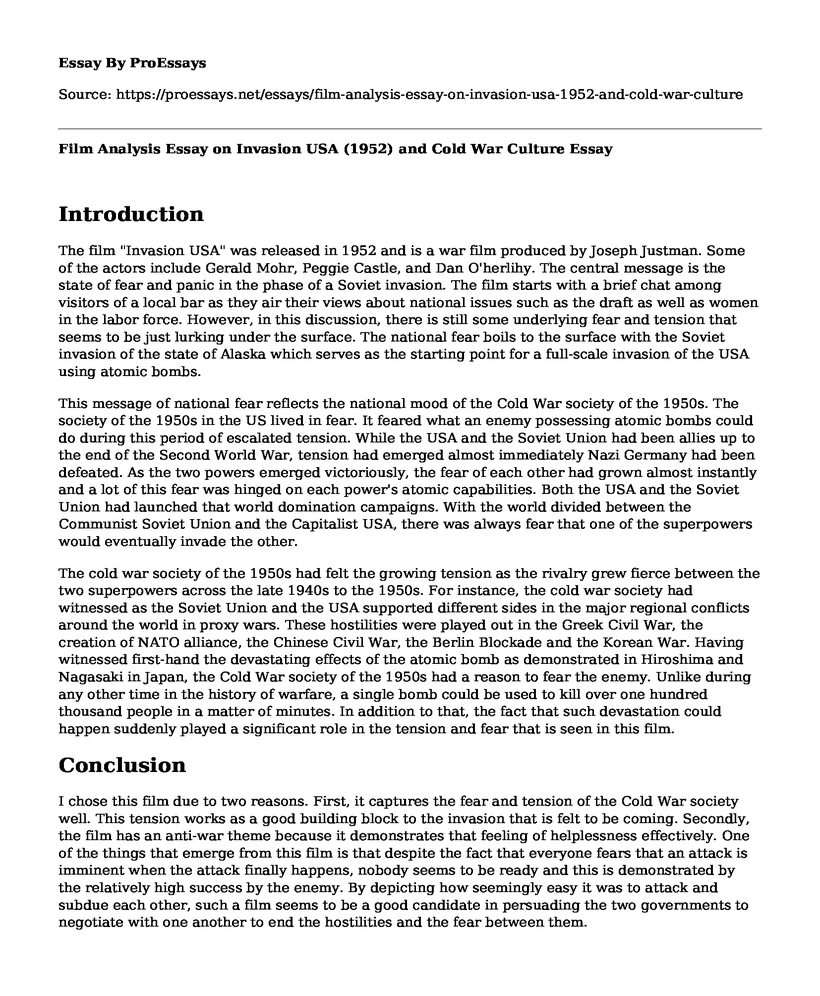Introduction
The film "Invasion USA" was released in 1952 and is a war film produced by Joseph Justman. Some of the actors include Gerald Mohr, Peggie Castle, and Dan O'herlihy. The central message is the state of fear and panic in the phase of a Soviet invasion. The film starts with a brief chat among visitors of a local bar as they air their views about national issues such as the draft as well as women in the labor force. However, in this discussion, there is still some underlying fear and tension that seems to be just lurking under the surface. The national fear boils to the surface with the Soviet invasion of the state of Alaska which serves as the starting point for a full-scale invasion of the USA using atomic bombs.
This message of national fear reflects the national mood of the Cold War society of the 1950s. The society of the 1950s in the US lived in fear. It feared what an enemy possessing atomic bombs could do during this period of escalated tension. While the USA and the Soviet Union had been allies up to the end of the Second World War, tension had emerged almost immediately Nazi Germany had been defeated. As the two powers emerged victoriously, the fear of each other had grown almost instantly and a lot of this fear was hinged on each power's atomic capabilities. Both the USA and the Soviet Union had launched that world domination campaigns. With the world divided between the Communist Soviet Union and the Capitalist USA, there was always fear that one of the superpowers would eventually invade the other.
The cold war society of the 1950s had felt the growing tension as the rivalry grew fierce between the two superpowers across the late 1940s to the 1950s. For instance, the cold war society had witnessed as the Soviet Union and the USA supported different sides in the major regional conflicts around the world in proxy wars. These hostilities were played out in the Greek Civil War, the creation of NATO alliance, the Chinese Civil War, the Berlin Blockade and the Korean War. Having witnessed first-hand the devastating effects of the atomic bomb as demonstrated in Hiroshima and Nagasaki in Japan, the Cold War society of the 1950s had a reason to fear the enemy. Unlike during any other time in the history of warfare, a single bomb could be used to kill over one hundred thousand people in a matter of minutes. In addition to that, the fact that such devastation could happen suddenly played a significant role in the tension and fear that is seen in this film.
Conclusion
I chose this film due to two reasons. First, it captures the fear and tension of the Cold War society well. This tension works as a good building block to the invasion that is felt to be coming. Secondly, the film has an anti-war theme because it demonstrates that feeling of helplessness effectively. One of the things that emerge from this film is that despite the fact that everyone fears that an attack is imminent when the attack finally happens, nobody seems to be ready and this is demonstrated by the relatively high success by the enemy. By depicting how seemingly easy it was to attack and subdue each other, such a film seems to be a good candidate in persuading the two governments to negotiate with one another to end the hostilities and the fear between them.
Bibliography
Kahn, Pip. Invasion USA (1952). Mar 3, 2013. www.youtube.com/watch?v=Mg8a9UMqSzY&t=1169s (accessed Mar 29, 2019).
Cite this page
Film Analysis Essay on Invasion USA (1952) and Cold War Culture. (2022, Dec 05). Retrieved from https://proessays.net/essays/film-analysis-essay-on-invasion-usa-1952-and-cold-war-culture
If you are the original author of this essay and no longer wish to have it published on the ProEssays website, please click below to request its removal:
- Is Social Media Contributing to the Rising Teen Suicide Rate?
- Social Media and Gun Control Essay Example
- Slacktivism Essay
- Paper Example on Minors and Social Networks
- Facebook Vs Twitter Survey
- Integrating Formal Elements in Art Creation - Free Essay Sample
- Analytical Essay Sample on the Importance of Reading for a Writer







